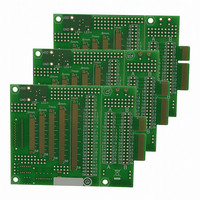AC164139 Microchip Technology, AC164139 Datasheet - Page 203

AC164139
Manufacturer Part Number
AC164139
Description
Graphics Display Prototype Board Graphics
Manufacturer
Microchip Technology
Specifications of AC164139
Main Purpose
LCD Development
Embedded
No
Utilized Ic / Part
PICtail™ Plus Board
Lead Free Status / RoHS Status
Lead free / RoHS Compliant
Secondary Attributes
-
Primary Attributes
-
Lead Free Status / RoHS Status
Lead free / RoHS Compliant
Available stocks
Company
Part Number
Manufacturer
Quantity
Price
Company:
Part Number:
AC164139
Manufacturer:
Microchip Technology
Quantity:
135
- Current page: 203 of 408
- Download datasheet (4Mb)
For 32-bit cascaded operation, these steps are also
necessary:
1.
2.
3.
4.
5.
6.
Depending on the output mode selected, the module
holds the OCx pin in its default state and forces a tran-
sition to the opposite state when OCxR matches the
timer. In Double Compare modes, OCx is forced back
to its default state when a match with OCxRS occurs.
The OCxIF interrupt flag is set after an OCxR match in
Single Compare modes and after each OCxRS match
in Double Compare modes.
Single-shot pulse events only occur once, but may be
repeated by simply rewriting the value of the
OCxCON1 register. Continuous pulse events continue
indefinitely until terminated.
2010 Microchip Technology Inc.
Set
(OCyCON2<8>) and (OCxCON2<8>). Enable
the even numbered module first to ensure the
modules will start functioning in unison.
Clear the OCTRIG bit of the even module
(OCyCON2),
Synchronous mode.
Configure the desired output and Fault settings
for OCy.
Force the output pin for OCx to the output state
by clearing the OCTRIS bit.
If Trigger mode operation is required, configure
the trigger options in OCx by using the OCTRIG
(OCxCON2<7>), TRIGMODE (OCxCON1<3>)
and SYNCSEL (OCxCON2<4:0>) bits.
Configure the desired Compare or PWM mode
of operation (OCM<2:0>) for OCy first, then for
OCx.
the
OC32
so the
bits
module
for
both
will
registers
run
PIC24FJ256DA210 FAMILY
in
14.3
In PWM mode, the output compare module can be
configured for edge-aligned or center-aligned pulse
waveform generation. All PWM operations are
double-buffered (buffer registers are internal to the
module and are not mapped into SFR space).
To configure the output compare module for PWM
operation:
1.
2.
3.
4.
5.
6.
7.
8.
9.
Note:
Configure the OCx output for one of the
available Peripheral Pin Select pins.
Calculate the desired duty cycles and load them
into the OCxR register.
Calculate the desired period and load it into the
OCxRS register.
Select the current OCx as the synchronization
source by writing 0x1F to the SYNCSEL<4:0>
bits (OCxCON2<4:0>) and ‘0’ to the OCTRIG bit
(OCxCON2<7>).
Select a clock source by writing to the
OCTSEL<2:0> bits (OCxCON<12:10>).
Enable interrupts, if required, for the timer and
output compare modules. The output compare
interrupt is required for PWM Fault pin utilization.
Select the desired PWM mode in the OCM<2:0>
bits (OCxCON1<2:0>).
Appropriate Fault inputs may be enabled by using
the
Register 14-1.
If a timer is selected as a clock source, set the
selected timer prescale value. The selected
timer’s prescaler output is used as the clock input
for the OCx timer, and not the selected timer
output.
Pulse-Width Modulation (PWM)
Mode
ENFLT<2:0>
This peripheral contains input and output
functions that may need to be configured
by the Peripheral Pin Select. See
Section 10.4 “Peripheral Pin Select
(PPS)” for more information.
bits
as
DS39969B-page 203
described
in
Related parts for AC164139
Image
Part Number
Description
Manufacturer
Datasheet
Request
R

Part Number:
Description:
Manufacturer:
Microchip Technology Inc.
Datasheet:

Part Number:
Description:
Manufacturer:
Microchip Technology Inc.
Datasheet:

Part Number:
Description:
Manufacturer:
Microchip Technology Inc.
Datasheet:

Part Number:
Description:
Manufacturer:
Microchip Technology Inc.
Datasheet:

Part Number:
Description:
Manufacturer:
Microchip Technology Inc.
Datasheet:

Part Number:
Description:
Manufacturer:
Microchip Technology Inc.
Datasheet:

Part Number:
Description:
Manufacturer:
Microchip Technology Inc.
Datasheet:

Part Number:
Description:
Manufacturer:
Microchip Technology Inc.
Datasheet:











